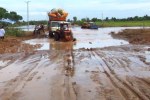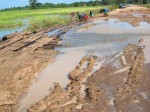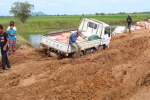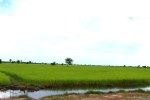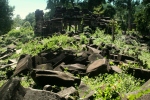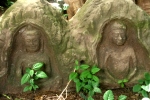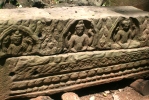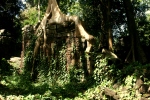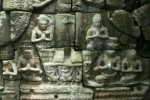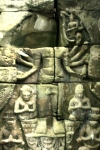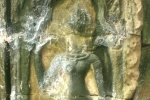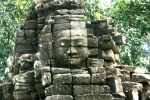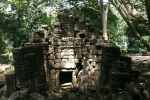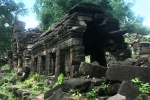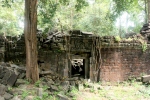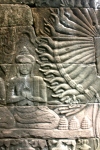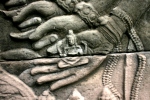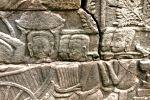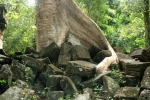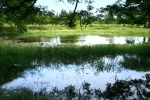Banteay Chamaar (Citadel of the Cat) is in north-western Cambodia, about 170 kilometres from Siem Reap. From Siem Reap you head west on the well-made National Road 6, the major road from Cambodia to Thailand, through the market town of Kralang and on to Sisophon, the major town on the way to the Thai border at Poipet. It’s a very pleasant drive to Sisophon, particularly late in the year when the emerald green rice paddies stretch seamlessly to the horizon. The road remained open during the recent floods.
Things change dramatically when you turn north at Sisophon. A dirt road through the back blocks of Cambodia for 70 kilometres was in very poor condition after the floods, heavily corrugated, and very slow going. A 5 and a half hour trip, assisted by having to wait a couple of times to get through flooded areas where local ingenuity provided access for a small fee, on one occasion by tractors acting as tow trucks, and at another problem area where a passable surface had been provided with bits of wood and old tyres. Along the way there were endless sights of rural Cambodia, poor and remote but without squalor. (Another new road, 68 from Kralang then 56, brings you to Kouk Moan, from where it is a shorter dirt road to the temple).
Banteay Chamaar is in the middle of nowhere. Covered by a forest canopy, and prone to heavy overgrowth, the story goes that only 50 years ago the local village leader didn’t know that it existed when a British archaeologist ventured to the temple. It is the only Angkor temple I have been to where there are no souvenir sellers and food stalls. Not even one. Nor are there any between Siem Reap and the temple.
Very little restoration has been done, although a small team led by the Global Heritage Fund from California has been doing some work for the past 3 years. There are fallen walls, collapsed galleries, trees and plants growing everywhere, blocks of fallen sandstone lying around, and lots of clambering to be done. It’s splendid, undisturbed, shambolic and thought-provoking. Why was it built out here? Why was it abandoned and allowed to fall into ruins? How powerful is nature when even a building as large, solid and strong as this can be overthrown by nature?
There are still wonderful carvings to be found by the adventurous, even though some idiots stole 11 metres of them in 1998. They were recoved by the Thai police and half were returned to Cambodia where they rest in the National Museum in Phnom Penh. Only 20% of the carvings on the outer enclosure wall remain but that is enough for us to be enthralled by the detail, craftmanship and beauty of them.
It is a large area, the walls being 200 metres x 250 metres, covering 22 acres, although the entire area including the large baray (a man-made lake probably constructed for irrigation) covers 3000 acres. There are a few face towers of the Bayon style although not as large. Originally there were 45, but apart from a few the others are in in ruins somewhere on the ground. They are believed to have been the prototypes for the Bayon faces. On the outside of the western enclosure wall are 4 extraordinary multi-armed Avalokiteswara, which are a highly revered bodhisattva in Mahayana Buddhism, the type practiced by the Khmers.
Inevitably the number of visitors has increased in the last couple of years, but it is still seldom visited. No-one had been there in the 3 weeks previous to our visit. Hopefully it can remain out of the reach of tourist buses. There are dozens of temples for them. They don’t need to take over every site. There is a place for some temples that retain their mystery, where those who make the effort to visit them are rewarded with the opportunity to observe and experience the tranquility and power of nature as it slowly reclaims the greatest efforts of humans, where it is possible to observe what happens to structures that are left unprotected against the forces of nature.
- the tow trucks were very busy
- It’s a long way there
- I have a slight problem
- Rice paddies forever
- Main entrance.
- 2 Buddhas
- Under restoration
- Nature conquers man
- Missing a part but no less interesting as a result
- Cobwebs and mould yet still fascinating
- Bayon face a long way from Bayon
- Light penetrates the jungle to the door
- Temple to Vishnu near the west gopura.
- Avalokiteswara
- In the palm of my hand. A close-up of the Avalokiteswara
- Exquisite detail
- Nature conquers man
- At the main entrance. It’s a very quiet place.
- Surroundings in the middle of nowhere

